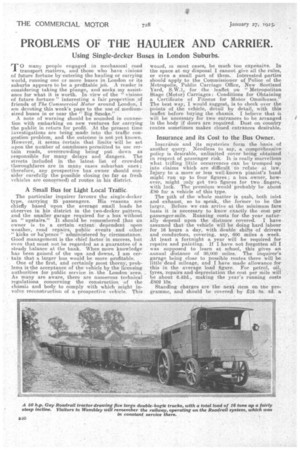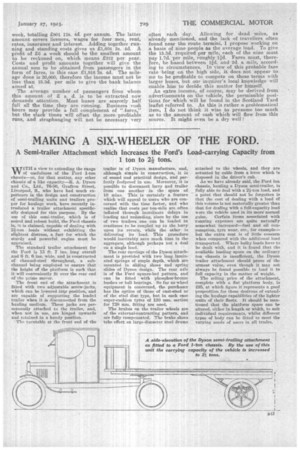PROBLEMS OF THE HAULIER AND CARRIER.
Page 24

Page 25

If you've noticed an error in this article please click here to report it so we can fix it.
Using Single-decker Buses in London Suburbs.
Tmany people engaged in mechanical road transport matters, and those who have visions of future fortune by entering the hauling or carrying world, running one or more buses in London or its suburbs appears to be a profitable job. A reader is considering taking the plunge, and seeks my assistance for what it is worth. In view of the " visions of future fortune" interesting a fair propertion of friends of The Commercial Motor around London, I am devoting this week's page to the use of mediumsized buses in or near the " Big Smoke."
A note of warning should be sounded in connection with embarking on new ventures for carrying the public in return for profit. At the present time investigations are being made into the traffic congestion problem, and the outcome is not yet known. However, it seems certain that limits Will be set upon the number of omnibuses permitted to use certain roads, overcrowding being put down as responsible for many delays and dangers. The streets included in the latest • list of crowded thoroughfares are in many cases suburban ones ; therefore, any prospective bus owner should consider carefully the possible closing (so far as fresh vehicles are concerned) of ratites in his district.
A Small Bus for Light Local Traffic.
The particular inquirer favours the single-decker type, carrying 25 passengers. His reasons are chiefly based upon the average small loads he observes in his district in the two-decker pattern, and the smaller garage required for a bus without an " upstairs." It should be remembered that an owner is to a certain extent dependent upon weather, road repairs, public events and other " kicks or ha'pence " administered by Circumstance. Good management is the chief factor in success, but even that must not be regarded as a guarantee of a steady balance at the bank. When more knowledge has been gained of the ups and downs, I am certain that a larger bus would be more profitable.
. One of the first, and certainly ;Post thorny, problems is-the acceptance of the vehicle by the lieensing authorities for public service M the London area'. As many are aware, there are numerous technical regulations concerning the construction of the chassis and body to comply with which might involve reconstruction of a prospective vehicle. This
would, in most cases, be much too expensive. In the space at my disposal I cannot give all the rules, or even a mall part of them. Interested parties should apply to the Commissioner of Police of the Metropolis Public Carriage, Office, New Scotland Yard, SAIT.1, for the leaflet on " Metropolitan Stage (Motor) Carriages: Conditions for Obtaining a Certificate of Fitness for Motor Omnibuses." The best way, I would suggest, is to check over the points of the vehicle, detail by detail, with this leaflet before buying the chassis. I believe that it will be necessary for two entrances to be arranged in the body if doors are required. Dust on country routes sometimes makes closed entrances desirable.
Insurance and its Cost to the Bus Owner.
insurance and its mysteries form the basis of another query. Needless to say, a comprehensive policy is desirable, unlimited cover being obtained in respect of passenger risk. It is really marvellous what trifling little occurrences can be trumped up into claims which are difficult to refute at law. Injury to p, more or less well-known pianist's hand might run up to four figures ; a bus owner, however, might only get two figures for two .fingers, with luck. The premium would probably be about £30 for a vehicle of this type.
The pith of the whole matter is cash, both inlet and exhaust, so to speak, the former to be the larger. Before we can arrive at the minimum fare basis it is necessary to know exactly the cost per passenger-mile. Running costs for the year naturally depend upon the distance covered. I have assumed that the vehicle will be doing hard labour. for 16 hours a day, with double shifts of drivers and conductors, covering, say, 600 miles a week. At least a fortnight a year will be required for repairs and painting. If I have not forgotten all I, was supposed to learn at school, this gives an annual distance of 80,000 miles. The inquirer's garage being close to possible routes there will be little-dead mileage, and I have made allowance for this in the average load figure. For petrol, oil, tyres, repairs and depreciation the cost per Mile will be about 6.42d., making the year's running costs .2802 10s.
Standing charges are the next item on the programme, and should be covered by £15 8s. 4d. a week, totalling 28,0I 13s. 4d. per annum. The latter amount covers licences, wages for four men, rent, rates, insurance and interest. Adding together running and standing costs gives us £1,604 3s. 4d. A profit of 26 a week should be the smallest amount to be reckoned on, which means 231.2 per year. Costs and profit amounts together will give the annual sum to be obtained from passengers in the form of fares, in this case 21,910 3s. 4d. The mileage done is 30,000, therefore the income must not be less than 15.3d. per mile to give the bank balance aimed at. The average number of passengers from whom this amount of 2 s. d. is to be extracted now demands attention. Most buses are scarcely half full all the time they are running. Business rush hours may provide a full complement of " fares," but the slack times will offset the more profitable runs, and straphanging will not be necessary very often each day. Allowing for dead miles, as already mentioned, and the lack of travellers often found near the route termini, I propose working on a basis of nine people as the average load. To give the I5.3d required per mile, each of the nine must pay 1.7d. per mile, roughly 11d. Fares must, therefore, be based between 10. and 2d. a mile, according to circumstances. In view of this probable fare rate -being on the high side, it does not appear to me to be profitable to compete on these terms with larger buses, but our inquirer's local knowledge will enable him to decide this matter for himself. An extra income, of course, May be derived from advertisements on the vehicle, the permissible positions for which will be found in the Scotia,nd Yard leaflet referred to. As this is rather a problematical item, I do not think it wise to presume too much as to the amount of cash which will flow from this source. It might even, be a dry well!






























